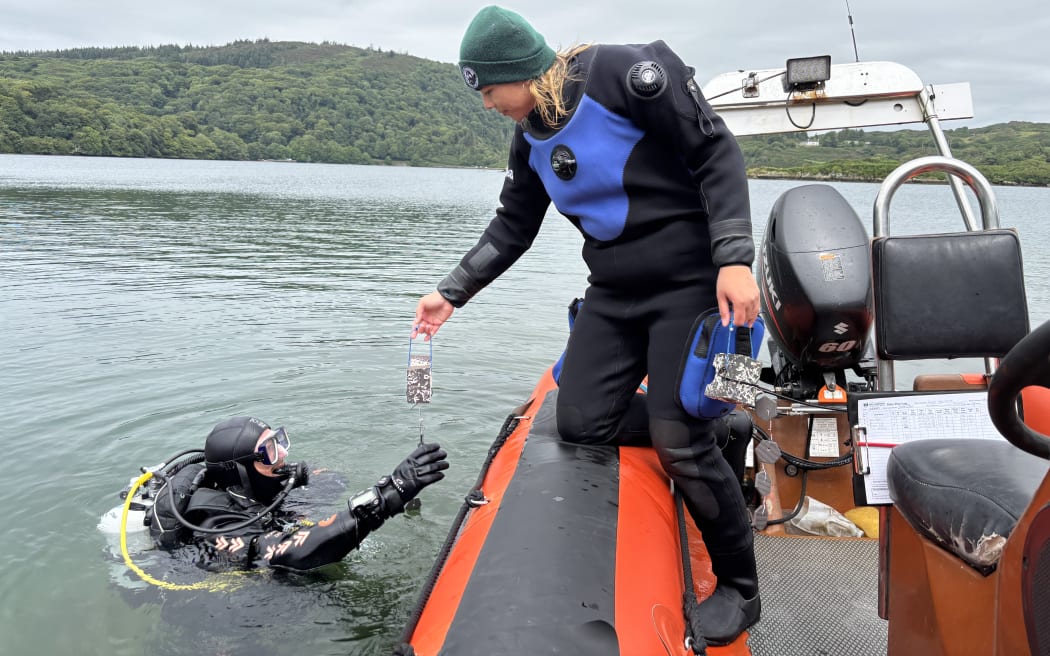World
Researchers Tackle Sponge Disappearance in Lough Hyne Reserve

Efforts to understand the recent decline of sponge populations in Lough Hyne, Ireland’s oldest marine reserve, are underway, led by researchers from New Zealand and Ireland. Gabi Wood, a PhD candidate at Victoria University of Wellington, is working on this critical project that aims to restore the sponge communities within the reserve.
Lough Hyne, located in southwest Cork, is a picturesque inlet that became Europe’s first marine reserve in 1981. It is home to over 1,800 species, making it a vital ecological area. Wood has spent several summers there, studying the marine life and the factors contributing to the disappearance of sponges, specifically the species Cliona celata.
The sponge populations were first noted to be declining in 2016, a concern raised by Wood’s supervisor, Professor James Bell. During a conference in Galway, he discovered that many sponges had vanished from the cliffs of Lough Hyne, which had previously been rich in sponge communities. This prompted further investigation into the reasons behind this unexpected decline.
Research has revealed that sponges play a crucial role in maintaining marine ecosystems. They provide habitats for other marine life and feed on phytoplankton and bacteria, contributing to the overall health of their surroundings. Despite extensive experimentation, the causes of the sponge disappearance remain unclear.
In the lab, Wood and her team have subjected the sponges to various environmental changes, including warming and increased nitrogen levels. While the sponges displayed resilience to these factors, another potential culprit has emerged: hydrogen sulfide. This gas can accumulate in low-oxygen areas, a condition that occasionally occurs in Lough Hyne during the summer months.
As the research progresses, some sponges have begun to show signs of recovery in certain areas of the loch. Utilizing a long-term dataset, researchers have been able to document the changes in sponge communities through photographs taken biannually at eight locations. This effort is being led by New Zealander Kea Witting, who is analyzing the patterns of recovery among the sponge populations.
The team is also exploring innovative methods to aid sponge recovery. They are experimenting with transferring sponges attached to rocks from one location to another and using tiles to promote natural sponge growth. These techniques aim to enhance the resilience of sponge communities and could potentially inform restoration efforts globally.
Professor Bell emphasizes the broader implications of their work, stating, “The techniques that we develop here at the loch will be useful to anybody doing restoration of sponges anywhere in the world.” He acknowledges that while Lough Hyne is unique, the findings could have significant applications for sponge ecosystems globally.
This research not only aims to understand the factors affecting sponge populations in Lough Hyne but also serves as a real-world application of marine science, with the potential to prevent similar declines in other regions. As the team continues its investigations, the hope is that the lessons learned will contribute to the preservation of vital marine ecosystems around the world.
-

 World1 week ago
World1 week agoPrivate Funeral Held for Dean Field and His Three Children
-

 Top Stories2 weeks ago
Top Stories2 weeks agoFuneral Planned for Field Siblings After Tragic House Fire
-

 Sports3 months ago
Sports3 months agoNetball New Zealand Stands Down Dame Noeline Taurua for Series
-

 Entertainment3 months ago
Entertainment3 months agoTributes Pour In for Lachlan Rofe, Reality Star, Dead at 47
-

 Entertainment2 months ago
Entertainment2 months agoNew ‘Maverick’ Chaser Joins Beat the Chasers Season Finale
-

 Sports3 months ago
Sports3 months agoSilver Ferns Legend Laura Langman Criticizes Team’s Attitude
-

 Sports4 weeks ago
Sports4 weeks agoEli Katoa Rushed to Hospital After Sideline Incident During Match
-

 Politics2 months ago
Politics2 months agoNetball NZ Calls for Respect Amid Dame Taurua’s Standoff
-

 World2 weeks ago
World2 weeks agoInvestigation Underway in Tragic Sanson House Fire Involving Family
-

 Top Stories2 weeks ago
Top Stories2 weeks agoShock and Grief Follow Tragic Family Deaths in New Zealand
-

 Entertainment3 months ago
Entertainment3 months agoKhloe Kardashian Embraces Innovative Stem Cell Therapy in Mexico
-

 World4 months ago
World4 months agoPolice Arrest Multiple Individuals During Funeral for Zain Taikato-Fox





















